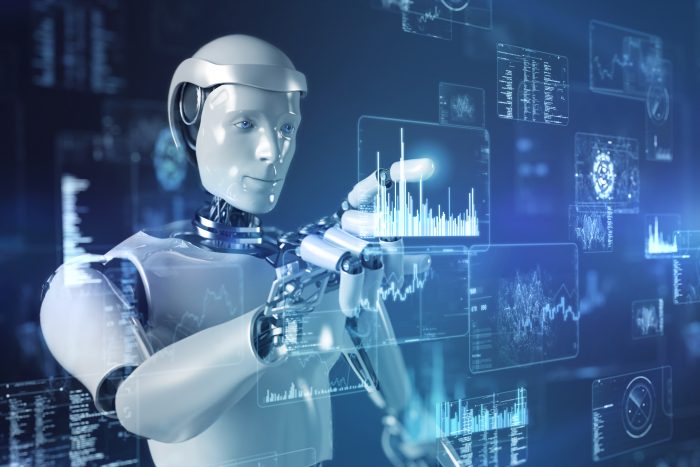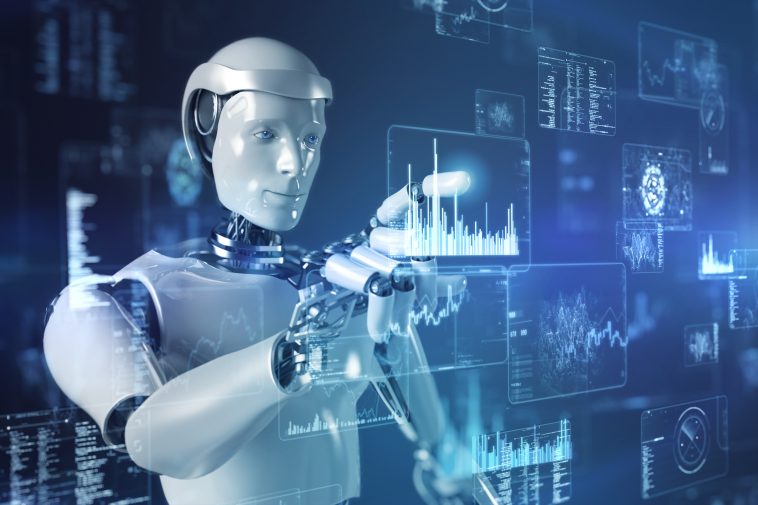1. The development of artificial intelligence in the United States
At present, the competition for global artificial intelligence leadership has entered a white-hot stage. In recent years, the United Kingdom, France, Germany, Canada, Japan, India, Singapore and other countries have successively released artificial intelligence strategies to actively promote artificial intelligence research and development and industrial applications. With the rapid development of modern science and technology, major breakthroughs have been made in the computing power, algorithms and massive scene data of machines, which has brought artificial intelligence back to life, showing a trend of blowout. Although the United States is the first to use advanced technologies such as big data, cloud computing, and the Internet of Things to occupy a leading position in the digital economy, if the United States wants to maintain leadership in the field of artificial intelligence, it also needs to formulate corresponding policies according to its own political, economic and military needs. artificial intelligence strategy.

1.1 U.S. AI Strategic Policy
The U.S. federal government has successively issued a number of important reports and documents to lead and boost the development of the national strategy for artificial intelligence. In 2016, the Obama administration launched the “Preparing for the Future of Artificial Intelligence” in October in response to the development status, application fields and social and public policy issues of artificial intelligence, and then released the “National Artificial Intelligence Research and Development Strategic Plan” to prioritize the development of artificial intelligence. Seven major R&D strategies for intelligence and two major recommendations, in December 2016, in the “Artificial Intelligence, Automation and Economic Report” document, the impact of AI-driven automation on the U.S. job market and economy, and constructive policy responses were systematically conducted Research and in-depth analysis. In February 2019, President Trump signed “Maintaining America’s Leadership in Artificial Intelligence”, launching the American Artificial Intelligence Initiative, marking the United States’ official promotion of artificial intelligence as a national strategy. The Trump Administration emphasizes that continuing U.S. leadership in artificial intelligence requires a concerted effort to advance technological and innovation advancements, protect U.S. technological, economic security and national security, and strengthen cooperation with foreign partners and allies . On March 1, 2021, the National Security Council on Artificial Intelligence (NSCAI) submitted a 756-page recommendation report to Congress. The report’s key recommendations include setting 2025 goals for U.S. AI development to achieve “military AI readiness”; creating a Vice President-led Technology Competitiveness Council at the White House to help advance AI in various fields position and vigorously cultivate skilled personnel.
Although the national AI policies of the Obama, Trump and Biden administrations have some emphasis, they generally show a relationship between the past and the future. Economic prosperity, enhanced economic security and national security.
1.2 Promote the military application of artificial intelligence
The U.S. government believes that artificial intelligence will affect every corner of the Department of Defense, including personnel recruitment training, operational implementation, weapons upgrades, equipment maintenance, health care and many other aspects. Artificial intelligence will change the way operations are fought and the character of future warfare. By exploiting the potential of AI to comprehensively transform the role of the Department of Defense, the U.S. Joint Force can better protect the interests of U.S. service members, citizens, allies, and partners, and improve the operational capabilities and efficiency of the force. In order to maintain the leadership of the US military in the field of artificial intelligence, the Department of Defense will strive to promote the technological progress and practical military applications of artificial intelligence.
The U.S. Department of Defense attaches great importance to AI’s mission-critical support. The U.S. government believes that artificial intelligence is of great significance for the U.S. military to enhance situational awareness, improve the safety of operating equipment, implement predictive maintenance, and simplify business processes. The image analysis capabilities of AI can extract useful information from large amounts of raw data, enhancing the situational awareness and decision-making capabilities of military commanders. AI can help commanders choose the best course of action to minimize the risk of deploying troops. AI can enhance the safety of human-operated aircraft, ships and vehicles in complex situations by warning operators of potential hazards. AI can automatically predict the failure of critical military components and provide maintenance plans based on relevant data and equipment conditions. This not only prevents equipment accidents from affecting military operations, but also optimizes spare parts inventory levels, allowing commanders to deploy troops quickly and at a lower cost.
1.3 Artificial intelligence-related talent training
The core of artificial intelligence competition among countries is the competition of talent stock and talent quality, which involves the ability to cultivate talents, the level of talent cultivation, and the continuous output ability of various talents. At present, all countries lack high-level and leading artificial intelligence talents. How to cultivate high-level artificial intelligence talents in a short period of time is a problem that all countries are thinking about together. In the artificial intelligence policy of the United States, the cultivation of professional talents and the building of talent teams are the key tasks, and are supported by measures such as financial support, R&D investment, and platform construction. The 2019 Executive Order to Preserve U.S. Leadership in Artificial Intelligence mandates that the provision of educational grants be considered a priority for existing federal scholarship and service programs, and to improve access to groups traditionally underrepresented in computing and related fields. Engagement, nurturing professionals of AI R&D personnel across disciplines and skill categories, etc. At the same time, the United States has put forward the talent training goal of “cultivating a group of diverse and ethical AI teams in an all-round way to maintain the leadership of the United States”.
2. The problem with artificial intelligence in the United States
2.1 On-site intelligence is not resolved
The so-called field intelligence is the embedding of autonomous systems into the environment, with the ability to perceive or measure the environment, to be able to assess the situation, think about the situation, make decisions to achieve goals, and then act on the environment to form an iterative and interactive “observation”. /Think/Act” closed loop. Ability to use several different modes of “thinking” to solve problems (e.g., evaluation, reasoning, and decision-making), reasoning and planning from low-level rules to high-level rules, depending on the difficulty of the problem, flexible enough to handle surprises Condition.
Field intelligence can be adapted to the current focus on enhancing human performance and alleviating human constraints under stress related to task level, task time, environment, etc. In 2013, Johnson proposed perception-assessment-augmentation (SAA), which perceives the physical, physiological and psychological states of humans, considers the human situation under specific task goals, and evaluates the organized state according to performance goals, through various means, including human-computer interaction, decision aids and even changes in biochemical enhancers that enhance various human abilities based on the state being assessed. Obviously, if human capabilities are properly augmented, then the effects of stressors should be reduced, so the final perception and assessment of the human state should reflect this, only a smaller amount of human capability needs to be augmented over time, a closed loop of the process Features are very clear.
2.2 The problem of human-machine trust mechanism is still on the way
Trust is a fundamental social psychological concept and is a key factor in many domains beyond autonomy, including interpersonal relationships, economic communication, organizational productivity, interdisciplinary and intercultural cooperation, and electronic mediated transactions. There are many different definitions of trust, the widely cited definition being that the will of one party is vulnerable to the actions of the other party because the other party is expected to take actions that are particularly important to the trust, regardless of the ability to monitor and control that party. The transparency and traceability of autonomous system solutions are low. According to assumptions, considering factors such as the data used, reasoning methods, etc., autonomous systems lack “the ability to explain themselves”, and it is difficult for autonomous systems to justify its solution set. to gain the trust of mankind. The system lacks self-awareness and environmental awareness. Self-awareness includes the health of autonomous systems and component failure modes, and environmental awareness includes environmental stress or enemy attack. Both can unknowingly affect performance and proficiency, and exaggerate the confidence of autonomous systems-based solutions outside their nominal “range of work.”
Cognitive consistency and cognitive transparency are conducive to enhancing the trustworthiness of human-machine collaboration. Cognitive consistency refers to the degree to which autonomous systems and humans are consistent in underlying cognitive representations and cognitive processes. It is an extension of the notion of cognitive or psychological coherence within an individual and the problems that arise when that individual has to deal with cognitive dissonance. The lack of cognitive coherence affects the shared sense-making and subsequent trust that autonomous systems make in understanding the situation and taking action at the time. This approach is similar to how humans behave in similar situations. Cognitive transparency refers to the reasoning and actions taken by autonomous systems that are understandable to humans even without much cognitive consistency. Transparency provides humans with a means of tracking and validating an “audit trail” of evaluations and reasoning made by autonomous systems, and will help build trust even if automated problem solving methods differ from human methods.
2.3 There is no breakthrough in the problem of human-machine hybrid intelligence
When people and systems work together to complete a common task, if the understanding of common goals, task constraints, roles, etc. is insufficient, it may lead to inconsistency in the allocation of human-machine decision-making functions during the task execution process. The real problem of any uncoordinated human-machine system lies in how to grasp “change” and “good”, rather than “fast” and “evolution”. Otherwise, people are not people, machines are not machines, the environment is not the environment, and their respective advantages have not been brought into play. When they should be changed, they will remain unchanged, and when they should not change, they will change randomly. In addition, the way, timing, and function of human-machine mixing should be appropriate. The “good” of each other, neither sooner nor too late, neither fast nor slow, can they exert their respective advantages and achieve optimal matching. In an open real environment, the resulting intelligence and active effectiveness can be maximized.
The function allocation in the human-machine hybrid intelligence is part of the division of labor, and the other part is the ability allocation. Function allocation is passive and caused by external demands; capability allocation is active and generated by internal driving. In complex, heterogeneous, unstructured, nonlinear data/information/knowledge, human or human-like directional preprocessing is very important. When the problem domain is initially narrowed down, the machine has the advantages of being bounded, fast, and accurate. It can be played out; in addition, when a large amount of data/information/knowledge is obtained, the machine can also initially map them to several fields, and then the human can further process and analyze. The assimilation, adaptation and cross-balance of these two processes reflect the process of organic integration of human and machine.
In the field of artificial intelligence in the United States, there is still no major progress in the above-mentioned key problems of artificial intelligence, so the expected application effect has not been obtained. Therefore, the core of its research—human-machine hybrid intelligence and situational awareness mechanism is relatively vague and confusing. The resulting intelligence only describes factual calculations, and lacks human emotion, value, and responsibility. As the intelligence of people varies widely, the most likely intelligent system that can realize efficient human-machine collaboration is a personalized intelligent system. The “personalized” intelligent system is not simply the adaptation and accommodation of machines to human habits, but should establish a framework and mechanism for human-machine communication. For example, the decision-making suggestions of DARPA’s intelligent auxiliary decision-making system may be a supplement to the commander’s thinking, or it may be completely opposite to the commander’s command style. Through continuous practice and running-in, multiple feedbacks are obtained, and the human-machine hybrid decision-making ability can be iteratively developed, and finally Realize a personalized auxiliary decision-making system to achieve the optimal match between human and machine.
3. Future trends of artificial intelligence in the United States
3.1 Explainable AI
The essence of interpretability is the knowledge of small data information, and it is also the secret of human learning. Since the development of artificial intelligence methods, a series of important breakthroughs have been traced back to the mining and application of a large number of knowledge bases containing human experience. However, for many typical applications, the quantity and quality of actual collected data cannot meet the needs of deep learning tasks, resulting in models that are often not interpretable when learning key behaviors of actual complex systems. In recent years, deep learning has promoted the leap-forward development of artificial intelligence, but technically, due to a large number of neural network parameters constructed, the complex hierarchical structure, and the deep coupling between parameters, the training and learning process of the neural network, the construction mechanism of the network layer, and the parameters The reliability of the characteristics and attributes is questionable. The goal of artificial intelligence is to learn the underlying laws of complex systems from data. Therefore, in-depth research on the interpretability, generalization performance, and repeatability of artificial intelligence methods is the core key scientific issue in the development of artificial intelligence in the current world. The United States There are no major breakthroughs either.
Existing artificial intelligence is based on prior experience and statistical models for data preprocessing and modeling analysis, and its mathematical essence is linearized dynamic modeling and analysis based on statistics. Big data analysis and artificial intelligence learning processes are based on statistical models or Evolution and optimization of linearized dynamic models that characterize or approximate the properties and behavior of the original complex system. The bottleneck in the development of traditional artificial intelligence is that its basic theoretical framework is based on statistical and dynamic linearization modeling ideas. Technologies such as machine learning and deep learning belong to this category. Although many non-linear explorations have made some progress, But none of them can break through the above framework.
3.2 Human-Machine Hybrid Intelligence
Artificial intelligence is only a descriptive and programmable part of human intelligence, and human intelligence is the product of the interaction of humans, machines (objects), and environmental systems. The matching grading of human-machine functions/capacities can be classified according to all labor, human-machine data assistance, human-machine rule-based computational reasoning assistance, human-machine probabilistic computational reasoning assistance, human-machine weak decision-making assistance, human-machine The main machine is strongly deterministic to assist in the decision-making division, but in any case, the human is always in the dominant position in the human-machine system, that is, the human is the main auxiliary in the whole process, so as to avoid the situation that the system is out of control.
Difficulties in the mechanism of human-computer hybrid intelligence: the mechanism of computing, the mechanism of intelligent computing (computing), the definition of basic concepts such as trust, understanding, intention, and adaptation in human-computer hybrid intelligence, and the demarcation of functions and capabilities in human-computer hybrid intelligence , adaptation, and intelligent calculation (calculation) The key lies in how to realize the dialectical unity of calculation and calculation (and for inverse calculation, inverse calculation can be paradoxical and contradictory, and inverse calculation can be infinitely looped), how to interact with situation / how to integrate perception , How to learn to think like an enemy and make objective judgments and inferences.
The United States maintains its global leadership in AI through top-down government policies (such as defense policy) and bottom-up corporate innovation ecosystems (such as antitrust laws). In terms of value leadership, the United States emphasizes that AI technology must reflect American core values, such as freedom, human rights protection, the rule of law, institutional stability, privacy rights, respect for intellectual property rights, and the opportunity for everyone to pursue their dreams. This requires AI technology to be understandable, credible, robust and secure, and to consider the broader impact of AI on society; in terms of actors, federal agencies, academia, private sector innovators and nonprofits Organizations, etc. play their unique and necessary roles, while these stakeholders work together mutually beneficially, creating positive synergies; in terms of data resources, it is U.S. policy to expand expert access to high-quality, valid, and fully traceable federal data, models, and and computing resources for federally funded artificial intelligence research and development to improve the competitiveness of U.S. artificial intelligence experts; in terms of human-machine collaboration, it emphasizes the complementary and enhanced role of artificial intelligence systems in human capabilities, through “replacement, enhancement, modification, re-engineering” “Plastic” and other ways to empower human beings;
4. Expect
4.1 Comprehensively strengthen basic research on artificial intelligence
According to the characteristics of large investment, long cycle and high risk in artificial intelligence basic research, from the aspects of team formation, support platform, funding investment, operation mechanism and policy guarantee, etc.
To meet the major needs of economic and social development and national security, focus on overcoming a number of major scientific and technological problems related to AI, and achieve major breakthroughs in forward-looking basic theoretical research and leading original results. It is necessary to break through the bottleneck of basic theory of application, focus on the basic theoretical direction with clear application goals and is expected to lead the upgrading of artificial intelligence technology, and strengthen basic theoretical research such as big data intelligence, cross-media perception computing, human-machine hybrid intelligence, swarm intelligence, autonomous collaboration and decision-making. . It is necessary to lay out cutting-edge basic theoretical research, and for the direction that may lead to the transformation of artificial intelligence paradigm, forward-looking layout of advanced machine learning, autonomous intelligent computing system, quantum intelligent computing and other cross-domain basic theoretical research.
4.2 Build a high-quality AI ecosystem
The artificial intelligence ecosystem is a dynamic open system with self-regulation and coordinated development composed of core values, management systems, participants, cultural systems, industrial applications, data resources, and supporting platforms. The so-called high-quality development refers to the interaction, coordination and cooperation between system elements to jointly promote each system element and the entire ecosystem towards a “higher quality, more efficient, fairer and more sustainable” development. develop. In order to accelerate the in-depth integration of artificial intelligence with the economy, society, and national defense, it is necessary to build an ecosystem in which knowledge groups, technology groups, and industrial groups are interactive and integrated, and talents, systems, and cultures support each other.
4.3 Strengthen the multi-integrated development of artificial intelligence
Continue to deepen the multi-integrated development of artificial intelligence technology, hoping to lead the future. Different from many traditional high and new technologies, the latest development of artificial intelligence technology began in the civilian field, and gradually shifted from the civilian field to military applications. At present, the institutions that master the most cutting-edge artificial intelligence technology are basically private high-tech enterprises, especially those engaged in Internet services, such as Google, IBM, Microsoft, Amazon and other companies. In this case, the military’s research cannot be relied on alone. Developed countries hope to control these technologies in their own hands for a long time, hindering the diffusion of technologies and leading a new round of technological revolution. Poorly based developing countries will have fewer and fewer opportunities to participate in international competition and world production.
4.4 Other suggestions
First, the top-level design of artificial intelligence is crucial.
Second, a key to the rapid development of artificial intelligence technology strategies in the future is the coordinated development of human-machine environment systems. The “people” here not only refer to professionals in the field of artificial intelligence, but also involve more complex talents; here The “machine” of artificial intelligence not only refers to the software and hardware in artificial intelligence machines, but also involves more mechanisms and mechanisms for collaboration between professions/industries/fields. Among them, the theoretical breakthrough of the basic mechanism theory of artificial intelligence will be the focus of attention of various countries. ;The “environment” here refers not only to the research and development environment in the field of artificial intelligence, but also to the cooperative innovation system environment of “government, industry, university, research and business” in more fields.
Third, get rid of the five philosophies, seek truth from facts, put people first, and establish the selection, training and development ecology of real compound talents/teams; set up relevant intelligent general courses in artificial intelligence, computer, automation, humanities and social sciences and other related majors; encourage relevant Enterprises carry out relevant training, permanent job recruitment, product pre-research intervention, etc.
Fourth, artificial intelligence products or systems are the coordinated development of human-machine environment systems, rather than the production or manufacture of a single artificial intelligence product or system. At the same time, it is necessary to distinguish the difference between automation and intelligence, and exclude artificial intelligence.
Fifth, the practical difficulty of ethics and values in intelligent technology research is the contradiction between interests and constraints (such as the balance between personal privacy and public safety in the use of face recognition), and the solution is to establish a theory that integrates Eastern ethics and Western laws and regulations system, learn from each other’s strengths and complement each other’s weaknesses, and achieve the institutional ecology of combining ethical pre-prevention and legal post-mortem punishment.
Sixth, the development of artificial intelligence in the future will no longer be a matter of one country, but the concerted efforts of the global community of shared future, striving to break the “encirclement and suppression” and establish a new order of the community of shared future for mankind.




GIPHY App Key not set. Please check settings